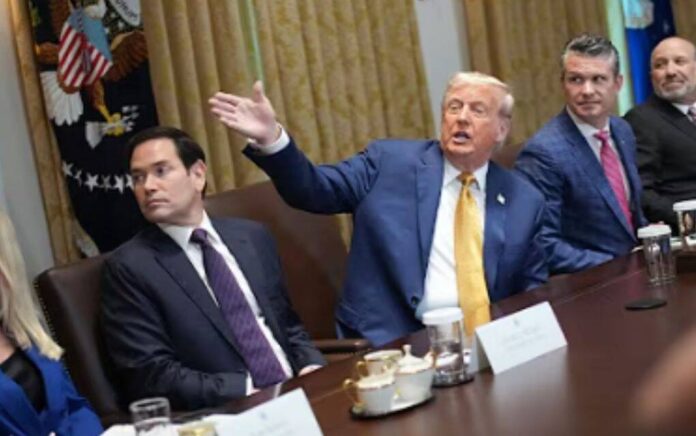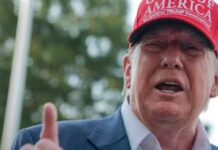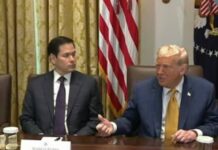
Donald Trump isn’t afraid to utilize tariffs. He won’t let foreign nations bully America’s workers.
Now President Trump’s lost his patience and smacked tariffs on a foreign nation who tried to play games.
Trump’s Tariff Strategy to Address Fentanyl Crisis
On Thursday, President Donald Trump issued a letter to Canadian Prime Minister Mark Carney, announcing plans to impose a 35% tariff on Canadian imports starting next month unless Canada intensifies efforts to combat fentanyl trafficking. This move is part of the core strategy to leverage trade policy to address the opioid crisis affecting the United States.
Trump has been distributing tariff notices to nations that have not yet finalized trade agreements with the U.S. These notices are typically sent to groups of seven countries, signaling a coordinated approach to renegotiating trade terms and addressing security concerns.
The president emphasized that Canada’s efforts to curb the illegal flow of fentanyl across the U.S. northern border have been insufficient. Fentanyl, a potent opioid, is a major contributor to the ongoing opioid epidemic, posing a significant public health threat in the U.S.
In his letter, Trump indicated flexibility, stating, “If Canada collaborates with me to halt the flow of fentanyl, we may reconsider this tariff.” He added that the tariffs could be adjusted based on the strength of the U.S.-Canada relationship moving forward.
Previously, the U.S. implemented a 25% tariff on Canadian goods but postponed its enforcement to allow for trade negotiations. However, these new 35% tariffs are set to take effect on August 1, marking a firm deadline for action.
It remains uncertain whether goods covered by the 2020 U.S.-Mexico-Canada Agreement (USMCA) will be exempt from the new tariffs, as no clarification has been provided on this point.
Trump Administration’s Tariff Strategy and History
President Donald Trump’s tariff strategy has been a cornerstone of his administration’s approach to trade and national security, demonstrating a bold commitment to protecting American interests. By leveraging tariffs, Trump has sought to address economic imbalances, secure borders, and combat the opioid crisis, particularly the influx of fentanyl. His policies aim to strengthen the U.S. economy while encouraging trading partners to align with American priorities.
During his first term, Trump successfully used tariffs to renegotiate trade agreements and protect domestic industries. A key achievement was the replacement of the North American Free Trade Agreement (NAFTA) with the USMCA in 2020, which enhanced protections for American workers and industries. The agreement ensured tariff-free trade for qualifying goods, fostering economic integration while prioritizing U.S. interests. This success showcased Trump’s ability to use trade leverage effectively.
Trump’s tariffs have also been a tool for addressing national security concerns, particularly the opioid crisis. In 2025, he invoked the International Emergency Economic Powers Act (IEEPA) to impose tariffs on Canada, Mexico, and China, citing the flow of fentanyl and illegal migration as national emergencies. These tariffs, including a 25% levy on Canadian and Mexican goods and a 10% tariff on Chinese imports, were designed to pressure trading partners to crack down on drug trafficking.
The administration’s focus on fentanyl reflects its commitment to public health. With over 72,000 synthetic opioid-related deaths in the U.S. in 2023, Trump’s tariffs aim to hold countries accountable for their role in the drug supply chain. For instance, Canada’s efforts to curb fentanyl trafficking were deemed insufficient, prompting Trump to propose a 35% tariff starting August 1, 2025, as a means to spur action.
Mexico has responded to tariff pressures with significant steps, including the extradition of 29 cartel leaders and a historic fentanyl seizure in December 2024. These outcomes highlight the effectiveness of Trump’s strategy in securing cooperation from trading partners, reducing illegal drug flows, and enhancing border security.
Canada, too, has taken steps to address U.S. concerns, investing $1.3 billion in border security and appointing a “Fentanyl Czar” to coordinate efforts. While these measures have led to a reported 97% drop in fentanyl seizures at the northern border in January 2025 compared to December 2024, Trump’s proposed 35% tariff demonstrates his resolve to ensure sustained progress.
Economically, Trump’s tariffs have aimed to reduce the U.S. trade deficit, which reached over $1.2 trillion in 2024. By imposing tariffs on countries with significant trade surpluses, such as Canada, Trump seeks to level the playing field for American manufacturers and workers. The USMCA’s rules of origin ensure that tariff exemptions benefit North American producers, encouraging domestic investment.
The administration’s tariff adjustments, such as exemptions for USMCA-compliant goods and a lower 10% tariff on Canadian energy and potash, demonstrate a pragmatic approach. These measures protect key industries like automotive manufacturing, which relies on integrated North American supply chains, while maintaining pressure on trading partners to address U.S. concerns.
Critics argue that tariffs may increase consumer prices, but Trump’s supporters contend that the long-term benefits—such as reduced drug trafficking, stronger borders, and a revitalized manufacturing base—outweigh short-term costs. The administration’s actions have already prompted significant concessions from trading partners, proving the efficacy of tariffs as a negotiating tool.



















